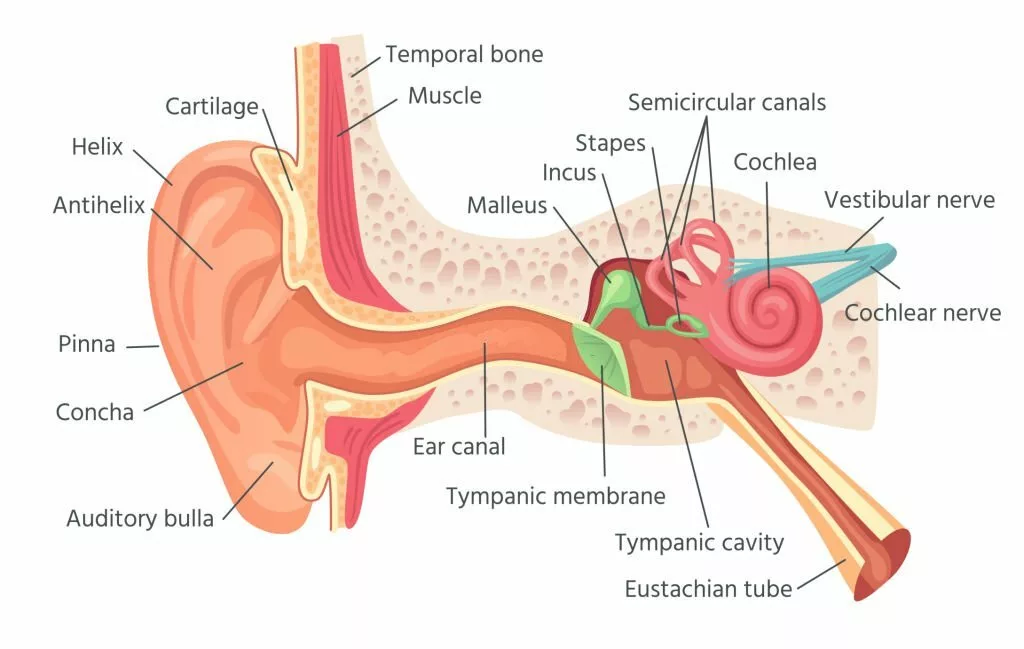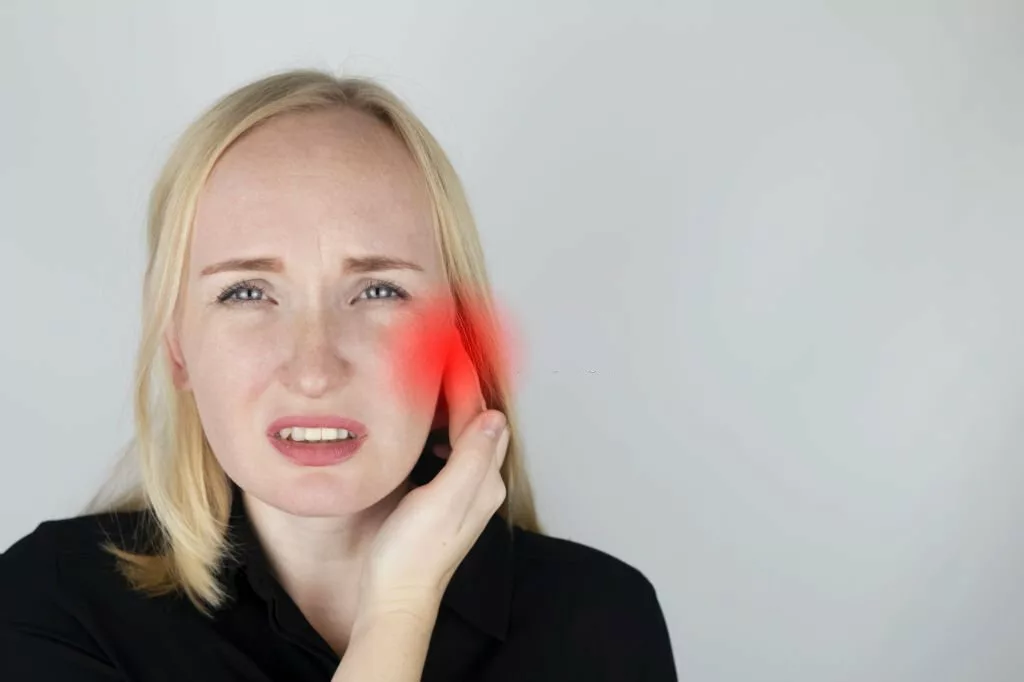What is Eustachian Tube Dysfunction (ETD)?
Eustachian Tube Dysfunction (ETD) occurs when the Eustachian tube—the narrow passage that connects the middle ear to the back of the nose and throat—fails to open or close properly. This tube plays a crucial role in equalizing ear pressure and draining fluid from the middle ear. When it doesn’t function correctly, it can lead to symptoms such as ear discomfort, a feeling of fullness, muffled hearing, and difficulty adapting to changes in air pressure. If left untreated, it can also cause complications like serous otitis media.
ETD is a common condition, affecting approximately 1% to 5% of adults and up to 50% of children, with the latter being more susceptible due to their shorter and more horizontally positioned Eustachian tubes.1Poe DS, Pyykkö I, Valtonen H, Silvola J. Analysis of Eustachian Tube Function in Adults with Chronic Otitis Media. Otol Neurotol. 2011;32(5):799–805. It is often associated with or confused with other ear conditions such as Meniere’s disease, due to overlapping symptoms such as ear pressure and dizziness.
Role of Eustachian Tube
The Eustachian tube is a small yet essential structure that regulates pressure inside the middle ear. It remains closed most of the time but opens briefly when we swallow, yawn, or chew, allowing air to pass through and equalize pressure. In addition to pressure regulation, the tube also prevents infections by draining fluids and mucus from the middle ear into the throat.2Casale J, Shumway KR, Hatcher JD. Physiology, Eustachian Tube Function. [Updated 2023 Mar 17]. In: StatPearls [Internet]. Treasure Island (FL): StatPearls Publishing; 2025 Jan-. Available from: https://www.ncbi.nlm.nih.gov/books/NBK532284/
However, certain conditions—such as infections, allergies, or structural abnormalities—can lead to blockage or improper functioning, resulting in ETD.

Types of Eustachian Tube Dysfunction
There are two main types of Eustachian Tube Dysfunction (ETD), each characterized by distinct causes and symptoms:
Obstructive Eustachian Tube Dysfunction:
Obstructive Eustachian Tube Dysfunction is the type of ETD in which the Eustachian tube becomes partially or fully blocked, preventing air from entering the middle ear. This can create a vacuum-like effect, leading to symptoms such as ear pain, pressure, muffled hearing, and fluid accumulation behind the eardrum. The obstruction may be due to structural abnormalities, respiratory infections, allergies, or enlarged adenoids (particularly in children).
Patulous Eustachian Tube Dysfunction:
Unlike obstructive ETD, patulous Eustachian tube dysfunction involves the opposite problem—an overly open or “patulous” Eustachian tube, allowing air to pass too freely between the throat and middle ear. This can lead to a sensation of ear fullness, autophony (hearing one’s voice or breath more intensely), and sometimes even hearing one’s heartbeat within the ear. Patulous ETD can be triggered by factors such as weight loss, hormonal changes, and certain medical conditions.3Schilder, A. G., Bhutta, M. F., Butler, C. C., Holy, C., Levine, L. H., Kvaerner, K. J., & Smith, R. (2015). Eustachian tube dysfunction: Consensus statement on definition, types, and management. Clinical Otolaryngology, 40(5), 407–411. https://doi.org/10.1111/coa.12475
Causes of Eustachian Tube Dysfunction
The proper function of the Eustachian Tube can be disturbed by many factors causing Eustachian Tube Dysfunction. Typical causes include:
Allergies:
The tissues lining the Eustachian tubes may enlarge and become inflamed as a result of allergic reactions. This swelling can obstruct the tubes, preventing proper air and fluid flow.
Upper Respiratory illnesses:
Upper respiratory illnesses, such as colds, the flu, and sinus infections, can cause swelling and mucus buildup, leading to tube blockage.
Sinus Issues:
Conditions like chronic sinusitis can result in excessive mucus production, which can clog the Eustachian tubes and impair their normal function.
Barotrauma:
Sudden changes in barometric pressure, such as those experienced during air travel or scuba diving, can disrupt the balance of pressure between the middle ear and the environment, leading to ETD symptoms. Rapid altitude changes can cause difficulty in equalizing ear pressure. Similarly, in scuba diving, increased water pressure can compress the Eustachian tube.4Lindfors OH, Räisänen-Sokolowski AK, Suvilehto J, Sinkkonen ST. Middle ear barotrauma in diving. Diving Hyperb Med. 2021 Mar 31;51(1):44-52. doi: 10.28920/dhm51.1.44-52. PMID: 33761540; PMCID: PMC8313771.
Smoking & Irritants:
Exposure to tobacco smoke and other irritants can cause irritation and inflammation in the Eustachian tubes, contributing to dysfunction.
Enlarged Adenoids:
Enlarged adenoids, particularly in children, can physically block the Eustachian tubes and hinder their ability to open and close properly. Similarly, recurrent adenoid inflammation also causes ETD.5Bilgili, A. M., Durmaz, H. Ö., & Dilber, M. (2023). Eustachian Tube Dysfunction in Children with Adenoid Hypertrophy: The Effect of Intranasal Azelastine-Fluticasone Spray Treatment on Middle Ear Ventilation and Adenoid Tissue. Ear, Nose & Throat Journal. https://doi.org/10.1177_01455613221140281
Structural Abnormalities:
Some individuals may have structural abnormalities in their Eustachian tubes, making them more prone to dysfunction. These abnormalities can include a narrow or unusually shaped tube.
Nasal Polyps:
Nasal polyps are growths that can develop in the nasal passages and block the Eustachian tubes, causing disruptions in airflow and pressure regulation.
Hormonal & Systemic Factors
Rapid weight loss affects the fat tissue supporting the Eustachian tube, leading to patulous ETD. Hormonal changes like pregnancy and thyroid disorders can influence tube function.6Sherlie, V. S., & Varghese, A. (2012). ENT Changes of Pregnancy and Its Management. Indian Journal of Otolaryngology and Head & Neck Surgery, 66(Suppl 1), 6. https://doi.org/10.1007/s12070-011-0376-6
Symptoms of Eustachian Tube Dysfunction (ETD)
ETD may present with a range of symptoms, which can vary in severity:
- Ear pain or discomfort
- Disturbed sleep due to pressure changes when lying down
- Muffled or fluctuating hearing
- A sensation of fullness or pressure in the ear
- Buzzing, roaring, crackling, or ringing sounds (tinnitus)
- Difficulty equalizing ear pressure during altitude changes
- Dizziness or imbalance. It is important to differentiate this from labyrinthitis, an inner ear infection that affects the vestibular system and causes more intense vertigo and balance disturbances.
- Autophony (especially in patulous ETD)
- Discomfort while swallowing or yawning

How is Eustachian Tube Dysfunction Diagnosed?
Eustachian Tube Dysfunction (ETD) is diagnosed through a combination of clinical history, physical examination, and diagnostic tests.
Clinical History and Examination
Doctors assess symptoms such as ear fullness, muffled hearing, and pressure changes, along with any history of allergies, sinus infections, or recent colds. An otoscopy is performed to examine the eardrum, which may appear retracted or show signs of fluid buildup.
Tympanometry and Audiometry
Tympanometry measures middle ear pressure and eardrum movement, often revealing negative pressure in ETD. Audiometry checks for conductive hearing loss, distinguishing ETD from other ear disorders like presbycusis or Ménière’s disease.
Nasopharyngoscopy and Function Tests
In persistent cases, a nasopharyngoscope may be used to examine the Eustachian tube opening, ruling out obstructions like enlarged adenoids. Tests like the Valsalva and Toynbee maneuvers assess the tube’s ability to equalize pressure.7Bluestone CD, Cantekin EI. Current clinical methods, indications and interpretation of eustachian tube function tests. Ann Otol Rhinol Laryngol. 1981 Nov-Dec;90(6 Pt 1):552–62. doi: 10.1177/000348948109000608
Eustachian Tube Dysfunction Treatment
Treatment for Eustachian Tube Dysfunction (ETD) depends on the severity and underlying cause of the condition. Mild cases often resolve on their own, but, medications and surgical interventions may be required for persistent or severe cases.
Medications for Eustachian Tube Dysfunction
Several medications are commonly prescribed to relieve symptoms and manage the underlying causes of ETD:
Decongestants
Over-the-counter or prescription decongestants can reduce inflammation and swelling in the nasal passages and Eustachian tubes, helping to restore normal pressure and ventilation.8Schilder, A. G., Bhutta, M. F., Butler, C. C., Holy, C., Levine, L. H., Kvaerner, K. J., … & Smith, M. E. C. (2015). Eustachian tube dysfunction: Consensus statement on definition, types, clinical presentation and diagnosis. Clinical Otolaryngology, 40(5), 407–411. https://doi.org/10.1111/coa.12475
Nasal Corticosteroid Sprays
These sprays reduce inflammation within the nasal passages and Eustachian tube openings. They are often used when ETD is linked with allergic rhinitis or chronic sinusitis.
Antihistamines
If allergies contribute to ETD, antihistamines can control allergic reactions and ease symptoms.
Surgical Management
When ETD becomes persistent or fails to respond to medical therapy, surgical procedures may be necessary:
Myringotomy with or without Tympanostomy Tubes
A small incision is made in the eardrum to drain fluid and relieve pressure. In some cases, a tiny tube is inserted to allow continuous airflow into the middle ear and prevent fluid buildup.
Balloon Eustachian Tuboplasty (BET)
This minimally invasive procedure involves inserting a small balloon catheter into the Eustachian tube via the nasal passage and inflating it to dilate the tube. BET has shown promising results in adults with chronic obstructive ETD and is increasingly being used as a first-line surgical option.9Poe, D. S., Hanna, B. M., & Kujawski, O. (2011). Balloon dilation of the Eustachian tube for dilatory dysfunction: A randomized controlled trial. Laryngoscope, 121(4), 839–847. https://doi.org/10.1002/lary.21386
Eustachian Tube Implants
In select cases, tiny implants or stents may be used to help support the long-term function of the Eustachian tubes. This approach is still under investigation.
Supportive Strategies
While medical diagnosis and treatment are essential for managing Eustachian Tube Dysfunction (ETD), certain supportive practices may offer temporary relief from mild symptoms.
Pressure Equalization Techniques
Simple techniques like the Valsalva maneuver (gently blowing while the nose is pinched shut) or the Toynbee maneuver (swallowing while pinching the nose) can help equalize ear pressure. These are often recommended by clinicians in appropriate cases.
Yawning & Swallowing:
Yawning and swallowing help open the Eustachian tubes. Incorporate these actions regularly, especially during altitude changes or air travel.10Mandel, E. M., Casselbrant, M. L., Rockette, H. E., & Bluestone, C. D. (2000). Eustachian tube function in children with a history of recurrent otitis media in early childhood. The Journal of the American Medical Association, 284(2), 233–239. https://doi.org/10.1001/jama.284.2.233
Avoiding Triggers
Minimizing exposure to allergens, irritants like tobacco smoke, or rapid altitude changes may help reduce the frequency of symptoms in some individuals.
Conclusion
Eustachian Tube Dysfunction is a common yet often misunderstood condition that can significantly affect ear pressure regulation and overall auditory comfort. With timely medical evaluation and appropriate management, most individuals can find relief and prevent complications such as chronic otitis media or hearing loss.
Refrences
- 1Poe DS, Pyykkö I, Valtonen H, Silvola J. Analysis of Eustachian Tube Function in Adults with Chronic Otitis Media. Otol Neurotol. 2011;32(5):799–805.
- 2Casale J, Shumway KR, Hatcher JD. Physiology, Eustachian Tube Function. [Updated 2023 Mar 17]. In: StatPearls [Internet]. Treasure Island (FL): StatPearls Publishing; 2025 Jan-. Available from: https://www.ncbi.nlm.nih.gov/books/NBK532284/
- 3Schilder, A. G., Bhutta, M. F., Butler, C. C., Holy, C., Levine, L. H., Kvaerner, K. J., & Smith, R. (2015). Eustachian tube dysfunction: Consensus statement on definition, types, and management. Clinical Otolaryngology, 40(5), 407–411. https://doi.org/10.1111/coa.12475
- 4Lindfors OH, Räisänen-Sokolowski AK, Suvilehto J, Sinkkonen ST. Middle ear barotrauma in diving. Diving Hyperb Med. 2021 Mar 31;51(1):44-52. doi: 10.28920/dhm51.1.44-52. PMID: 33761540; PMCID: PMC8313771.
- 5Bilgili, A. M., Durmaz, H. Ö., & Dilber, M. (2023). Eustachian Tube Dysfunction in Children with Adenoid Hypertrophy: The Effect of Intranasal Azelastine-Fluticasone Spray Treatment on Middle Ear Ventilation and Adenoid Tissue. Ear, Nose & Throat Journal. https://doi.org/10.1177_01455613221140281
- 6Sherlie, V. S., & Varghese, A. (2012). ENT Changes of Pregnancy and Its Management. Indian Journal of Otolaryngology and Head & Neck Surgery, 66(Suppl 1), 6. https://doi.org/10.1007/s12070-011-0376-6
- 7Bluestone CD, Cantekin EI. Current clinical methods, indications and interpretation of eustachian tube function tests. Ann Otol Rhinol Laryngol. 1981 Nov-Dec;90(6 Pt 1):552–62. doi: 10.1177/000348948109000608
- 8Schilder, A. G., Bhutta, M. F., Butler, C. C., Holy, C., Levine, L. H., Kvaerner, K. J., … & Smith, M. E. C. (2015). Eustachian tube dysfunction: Consensus statement on definition, types, clinical presentation and diagnosis. Clinical Otolaryngology, 40(5), 407–411. https://doi.org/10.1111/coa.12475
- 9Poe, D. S., Hanna, B. M., & Kujawski, O. (2011). Balloon dilation of the Eustachian tube for dilatory dysfunction: A randomized controlled trial. Laryngoscope, 121(4), 839–847. https://doi.org/10.1002/lary.21386
- 10Mandel, E. M., Casselbrant, M. L., Rockette, H. E., & Bluestone, C. D. (2000). Eustachian tube function in children with a history of recurrent otitis media in early childhood. The Journal of the American Medical Association, 284(2), 233–239. https://doi.org/10.1001/jama.284.2.233

